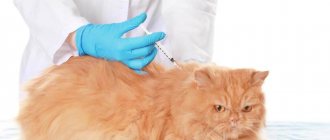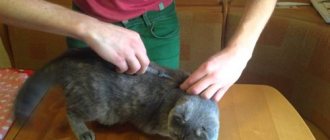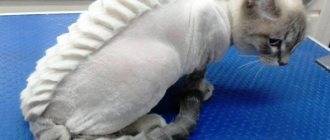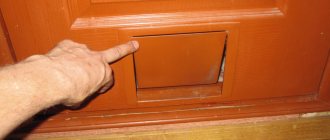For diseases, animals are often prescribed drugs in the form of subcutaneous injections. They have to be administered daily – and even several times a day. Visiting a veterinary clinic so often is inconvenient, harmful to a sick pet, and costly. If you understand how to inject a cat at the withers, you will be able to carry out all the manipulations at home. A familiar environment will reduce the animal’s stress level, and your own skills will help you save money.
Injections at home
In emergency situations, injections are given to the dog at home. There may be several reasons for home treatment.
Urgent need
Cases for emergency assistance: the animal has been seriously injured, is experiencing unbearable pain, the female has difficulty giving birth, or urgently needs to be injected with Oxytocin.
The owner is forced to administer an anesthetic, an antibiotic, a sedative, and a labor stimulant without waiting for the veterinarian to arrive.
No access to veterinary care
If the animal gets sick in a remote village, or weather conditions do not allow the dog to be taken to the clinic, the owner himself provides assistance to the animal.
Delay can cost the animal’s life; treatment cannot be delayed.
Animal in a stressful situation
A very frightened dog may not give itself into the hands of a stranger. Some animals experience stress from going to the veterinary clinic. If the situation does not require urgent medical attention, you can administer the medicine subcutaneously at home.
Desire to save money
A veterinarian's appointment, examination, and all subsequent manipulations are not cheap. In some cases, these expenses are not justified. Experienced dog breeders can easily handle subcutaneous injections without the assistance of a specialist.
Nervous behavior
It happens that after an injection and similar medical procedures, the cat becomes nervous, does not touch itself, and hides from you at every opportunity. In veterinary practice, this phenomenon is called a psychological attack.
This causes changes in the functioning of the nervous system, resulting in fear of injections, stress when visiting a veterinary clinic or even when seeing a person in a medical uniform.
- In this situation, there is nothing you can do, you can only wait.
- After some time, your pet will return to its original state.
- You can try to cope with this with the help of treats, preferably harmless (fish treats, pieces of dehydrated meat, etc.)
Young cats can be entertained with games or walks to distract them from the psychological attack, unless treatment involves reducing activity.
Syringe selection
Injecting requires a certain skill and a properly selected instrument. The choice of syringe depends on the size of the dog.
Breed and age of the dog
For puppies or small breed dogs, it is recommended to administer medications with an insulin syringe . It has the shortest and thinnest needle. It is not completely injected under the skin.
For large breeds, the syringe is selected according to the volume of medication administered. If it is necessary to inject 1 ml of a substance, use a 2 ml syringe. The needle is carefully inserted under the skin, deepening it by more than 1/3 of its length.
Type of drug
Subcutaneous medications are administered after consultation with a veterinarian. The appropriate drug must be used.
Substances for intravenous administration cause allergies or tissue death when they are introduced under the skin.
Medicines with an oily structure
Dense liquids are injected with a syringe with a thick needle. The drug will not leak through a thin one, like on insulin syringes, it will clog the hole.
Volume of injected fluid
If the dosage of the drug reaches 5 ml, you cannot take a 2 ml syringe and inject the substance several times.
The animal will not tolerate such execution. Select a syringe of the appropriate size. The needle from such an instrument can be thick; it is inserted very carefully, only the tip is pushed under the skin.
Contraindications
Carboxytherapy should not be used in the following cases:
- heart disease;
- myocardial infarction;
- heart failure;
- cardiac ischemia;
- dysfunctions of hematopoiesis and breathing;
- vein thrombosis;
- pregnancy;
- lactation period;
- epilepsy;
- liver and kidney failure;
- psychoneurological disorders;
- dermatological diseases in the injection area;
- suppuration and tissue necrosis;
- malignant neoplasms;
- incompatibility of medications taken.
Algorithm
Most drugs for animals are injected into the withers. This is the simplest manipulation that every owner should learn to do.
Procedure:
Wash the hands.- Turn the ampoule upside down and shake.
- Break it at its thinnest point.
- Use a syringe to draw out the required amount of medicine.
- Release the air from the syringe by pressing the plunger until a drop of liquid appears at the tip of the needle.
- Using two fingers, pull back the skin on the dog’s withers and remove the hair.
- Insert the needle under the skin at an angle of 45 ᵒ, carefully, slowly and without deepening it beyond the tip.
- Inject the medicine under the skin.
- Quickly remove the needle, holding the skin fold.
There is no need to disinfect the injection site before and after: dogs have a special protective layer on their skin. It is prohibited to touch the needle with your hands before administering the medicine.
The appearance of abscesses
Swelling and ulcers after injection can only appear if you performed this procedure incorrectly. A dangerous microorganism or bacterium penetrates into a small wound, resulting in an infection, accompanied in most cases by tissue inflammation.
The swelling may go away on its own after some time. If this does not happen, then an abscess forms, they are already removed through surgery, after the operation the veterinarian prescribes a course of anti-inflammatory drugs.
Animal location
It is important to position and secure your pet correctly in order to accurately administer the injection. This ensures that the animal will not jerk or run away at the most crucial moment.
Large animal
Shepherd, Great Dane, St. Bernard can sit on the floor. The dog should sit or lie stretched out on its legs. It is good to ask another family member to calm the animal down and restrain it so that it does not jerk or bite the person.
Small pet
It is convenient for a small dog to get an injection at an elevated location.
The pet is placed on a table or any other hard and flat surface level with the owner’s belt, the animal is calmed down, and one person fixes it. If the dog breaks out or bites, it is held by the head and body. At this time, the animal owner introduces the contents of the ampoule.
Preparation of the drug
Before the procedure, the medicine is taken out of the refrigerator, brought to room temperature, the ampoule is opened, and drawn into a syringe.
Bottle
Puncture the rubber lid of the container with a needle, immerse the tip inside, and draw out the required amount of the drug. The remains are hermetically sealed and sent to the refrigerator for storage. If the drug is not intended for further use, it is disposed of.
Ampoule
The container is cut with a special file, which is inserted into each package. Then the ampoule is broken at the thinnest point.
Basic rules and recommendations
When self-administering the drug, be sure to follow the rules of personal hygiene:
- before the procedure, wash your hands with soapy water and wipe with alcohol;
- use a disposable syringe, always sterile;
- do not touch the needle with your hand;
- a new sterile needle is required for each injection;
- do not use open ampoules.
Sometimes expensive drugs are intended for several injections. Don't start with a different bottle each time. It is enough to draw the recommended doses into various syringes and close them with plastic caps. Medicines should be kept in the refrigerator; shelf life should be indicated in the instructions for the medicine.
Although it is not always possible to use this method. For example, powdered medications are diluted immediately before the procedure , as they tend to create a sediment. Before use, the ampoules are warmed in your hands. The temperature of the medicine should be slightly higher than the ambient temperature.
Important! You cannot use a clean ampoule whose name has been erased. Check the expiration date of the drug, throw out expired copies.
In open boxes, check the name of the medicine. Since, quite possibly, during cleaning they put a single ampoule in an empty space in the box.
Read the instructions before use; you may need to shake the drug before use.
Prepare a special file for opening the ampoule. Wrap it with cotton wool and press in the opposite direction. Some copies have a mark. Then, insert the needle. For convenience, lift the ampoule upside down and draw the solution. After filling the container, squeeze out the excess air from the syringe with a piston.
Do not try to combine two medications into one device. A negative reaction and sedimentation may occur.
Decide on the type of injection. Not all drugs can be administered intramuscularly or subcutaneously. For example, calcium chloride is administered only intravenously, and diphenhydramine is suitable only for two types of injections: intravenously, intramuscularly. Any discrepancies can lead to tissue death and worsen the situation.
Types of injections
In addition to injections into the withers, dogs are given intravenous and intramuscular injections. Procedures are difficult to perform without training. Some of them are carried out only in a clinical setting.
Intravenous
Such injections are not given at home. Only a veterinarian can do them. Usually a special catheter is inserted into a dog’s vein, through which the drug is injected.
This is convenient, since the puncture is done only once.
Intramuscular
The owner can carry out the manipulation at home. It does not require special skills.
Action plan:
- Secure the animal.
- Fill the syringe with medicine.
- Squeeze all the air out of it.
- Inject the drug into the largest muscle on the hind leg.
During the procedure, the dog should lie down and not stand.
Subcutaneous
The drug is injected into the withers of the animal. This is a less traumatic and painful procedure for the animal.
Actions for good
First of all, come to terms with the idea that this is a necessity. Moreover, it is extremely important for the health of your pet. And of course, do not choose medications yourself. Only the veterinarian's prescription must be carried out unconditionally. By the way, in this case, an on-site specialist will explain to you how to give your cat an injection in the withers.
The second step is to calm down. Animals react very strongly to your emotions, so before you start chasing your cat, prepare a syringe, a blanket to wrap your pet in, and take a few deep breaths. Now you can go in search of the patient.
Adverse reactions
Even a simple medical procedure can cause complications. It is important for the dog owner to know what to do if the situation gets out of control.
Nerve hit
This can happen if the intramuscular injection is given incorrectly. After the injection, the dog may drag its paw. To avoid troubles, rub the injection site and massage the limb.
If the pain in the paw does not go away for a long time and the dog limps, it means that a bundle of nerves is affected. In this case, they contact the veterinarian and do a novocaine blockade.
There was blood in the syringe
Such a nuisance can occur with subcutaneous and intramuscular administration of the drug.
This means that a vessel or capillary is affected. This situation does not pose any danger to the dog. The needle is removed from the animal's body and inserted into another area. The blood should be blotted with a cotton swab soaked in antiseptic.
A hematoma has formed
If the needle does not enter the muscle correctly, or a large amount of medication is injected quickly, a hematoma will form. This is a slight swelling in the puncture area. Usually it goes away on its own. To speed up the process, this area is periodically rubbed and massaged.
If the lump increases in size, breaks out, or becomes painful, you should contact a veterinary clinic.
Why exactly the withers?
Only at first glance this procedure is so scary. It is easier to inject a cat subcutaneously into the withers because this place is not too sensitive. The mother lifts the little kitten for him, and he never expresses signs of dissatisfaction. However, piercing the withers with a needle can be difficult, especially if you hit a muscle.
But there are also physiological reasons for choosing a location. Subcutaneous fat has a loose structure and good absorption capacity. That is why large volumes of liquid, in particular oil solutions, can be injected into this part of the body. Due to their slow absorption, it is imperative to use medications warm and in small quantities.
The subcutaneous fat layer has a good blood supply, which provides excellent effects on all organs and systems. In this case, absorption occurs faster than when administered orally, but slower than when administered intramuscularly.
How to avoid complications
The consequences of improper administration of drugs require long-term treatment. Simple recommendations will help you avoid this.
Basic Rules:
The medicine is administered with a sterile syringe.- Manipulation is carried out only with clean hands.
- The syringe must be appropriate for the weight and age of the dog.
- Do not mix several medications in one syringe.
- The needle is not completely inserted into the skin or muscle.
We must not forget that the dog senses the owner’s uncertainty, so all actions are carried out quickly and clearly.











